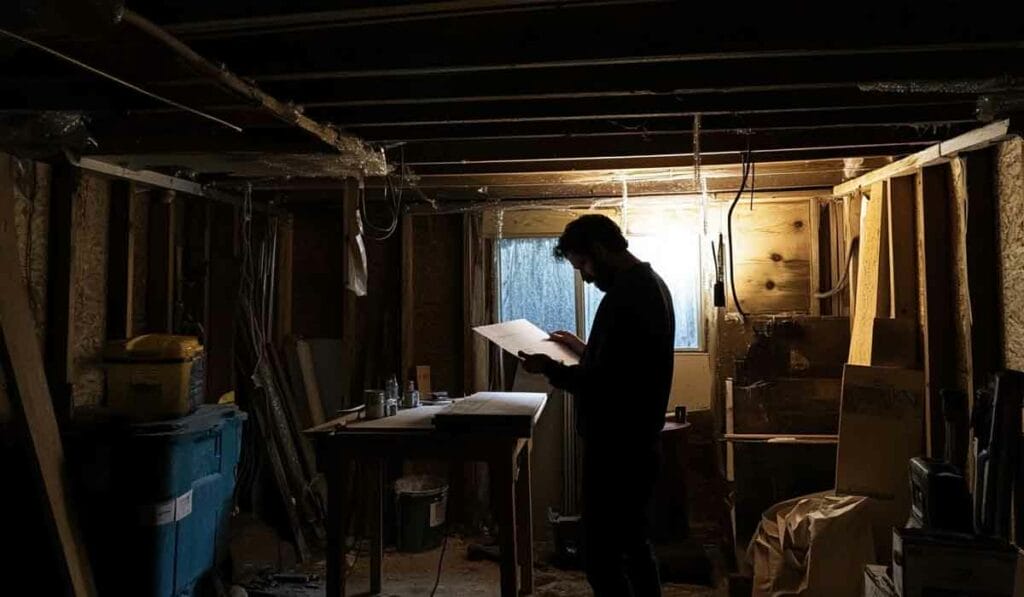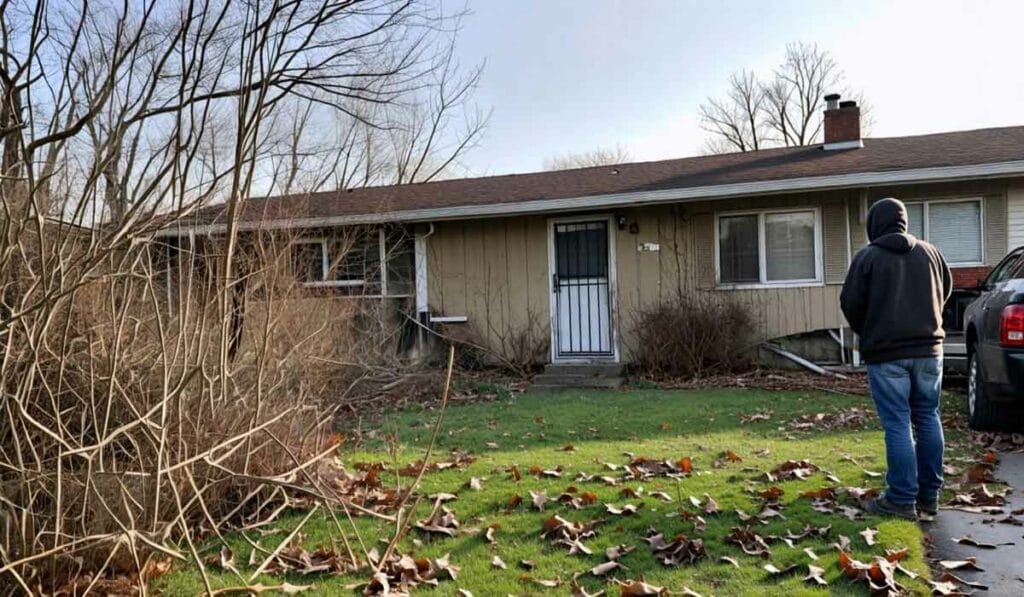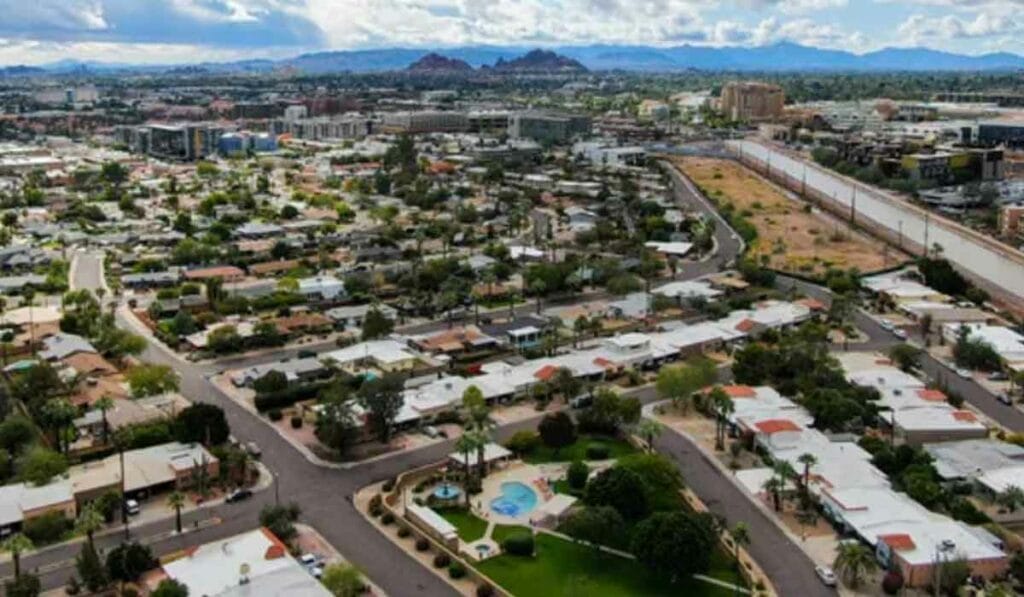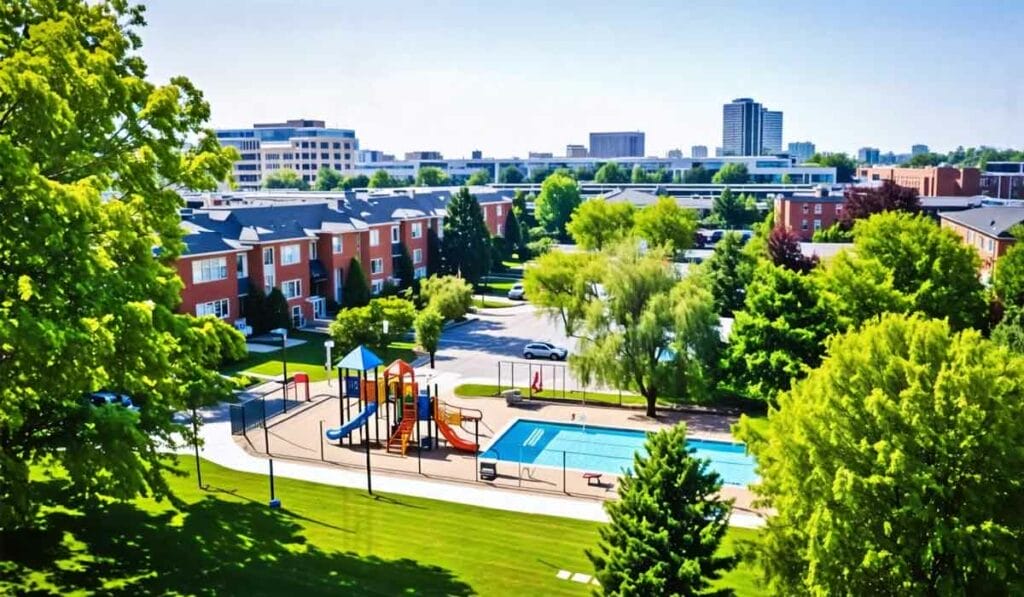
The BRRRR Method – A Complete Real Estate Investment Guide For Success
Tired of the daily grind and looking for a better way to build wealth?
The BRRRR real estate strategy could be your ticket out.
This method helps you buy, rehab, rent, refinance, and repeat properties effectively.
Stick around; this guide will break it all down for you.
Key Takeaways
- Clear Steps to Follow: The BRRRR strategy involves five steps: Buy, Rehab, Rent, Refinance, and Repeat. Each step builds upon the last to maximize returns on investment properties.
- Financial Advantages: This method allows investors to leverage equity from rehabilitated properties to buy more homes without needing constant new capital.
- Property Selection Tips: Identifying the right property is crucial. Focus on areas with growth potential and low crime rates and use the 70% rule for calculating purchase price.
- Funding Options: Financing can come from hard money loans for quick deals, private lenders for flexibility, or conventional loans for lower interest but longer approval times.
- Scalability and Growth: By repeating these steps, you can continuously reinvest your gains into new properties, building a large portfolio quickly while generating passive income.
Are You an Investor in Arizona?
Need a reliable hard money lender who can close in 24 hours?
We would love to be a choice on
your list of lenders to interview when you do the BRRRR Strategy.
Definition of BRRRR strategy
The BRRRR method stands for Buy, Rehab, Rent, Refinance, Repeat.
It’s a real estate investment approach designed to build wealth consistently.
First, you purchase a distressed property at a low price. Next comes rehab—think renovations and repairs that enhance its value.
Once fixed up, rent out the property to create steady cash flow.
Following this phase is refinancing; it involves pulling out your investment plus some profit through another loan based on the property’s new value. Finally, repeat these steps with another property using equity gained from refinancing.
Real estate cannot be lost or stolen… purchased with common sense, paid for in full and managed with reasonable care. – Franklin D. Roosevelt
Brief history and popularity of the strategy

Originally, real estate investors used separate strategies for buying and holding properties. In the 1990s, savvy investors began to notice they could combine these steps profitably.
The BRRRR strategy evolved from this observation and gained traction in the early 2000s.
Today, this method is popular among both novice and experienced property investors.
It allows you to build wealth through rental properties while leveraging your equity smartly.
Investors appreciate its cyclical nature and potential for scaling quickly without needing a constant influx of new capital.
Overview of potential benefits and risks

The BRRRR strategy has a rich history and consistent popularity in real estate investing. Many investors have adopted this method for its promising returns and structured process.
Now, let’s explore the potential benefits and risks involved with the BRRRR strategy.
This investment approach offers appealing advantages such as passive income, property appreciation, and scalable growth.
With each successful cycle of buying, rehabbing, renting out properties, refinancing to pull cash out, you can quickly build significant wealth while repeatedly reinvesting your gains into new ventures.
However, it’s not all sunshine and rainbows. The risks include unpredictable renovation costs, tenant issues that could lead to vacancies or damages, and fluctuating market conditions that might affect refinancing rates or rental demand.
Balancing these factors is key to making the most of your BRRRR journey.
Understanding the BRRRR Strategy

Each step in the BRRRR Strategy plays a key role.
First, you buy a distressed property at a low price.
Then, fix it up through rehab to increase its value. Next, rent out the newly renovated property to generate steady income.
After that, refinance the property based on its improved value to pull out your initial investment. Lastly, repeat the entire process using the pulled-out capital.
BRRRR differs from traditional real estate investing by being cyclical and scalable.
Traditional methods often involve buying ready-to-rent properties and holding them long-term without significant improvements or refinancing options for rapid expansion.
With BRRRR, you can quickly build your portfolio and wealth by recycling your cash across multiple investments.
Breakdown of each BRRRR step

The BRRRR real estate strategy involves five key steps to build wealth. Understanding each step helps you plan effectively and make informed decisions.
- Buy
- Identify undervalued properties in good neighborhoods.
- Assess property conditions for necessary repairs.
- Analyze market trends to verify potential value increases.
- Rehab
- Focus on essential repairs first – structural issues and major systems.
- Balance renovations between cost-effectiveness and return on investment (ROI).
- Create a detailed budget and timeline to manage expenses and progress.
- Rent
- Set competitive rental prices based on local market rates.
- Advertise the property using online listings, signs, and word-of-mouth.
- Screen tenants thoroughly to ensure reliable, long-term renters.
- Refinance
- Understand different refinancing options such as cash-out refinance or rate-and-term refinance.
- Time your refinancing when interest rates are favorable.
- Work with lenders who are familiar with the BRRRR strategy for smoother processing.
- Repeat
- Use equity from refinanced properties to fund new purchases.
- Build a portfolio efficiently by managing multiple properties at once.
Buy

Start by finding the right property. Look for a place with good potential in prime locations.
Check its condition thoroughly; you need to know if it needs major repairs or just some touch-ups.
Use the 70% rule as your guide.
This means paying no more than 70% of the property’s after-repair value (ARV) minus rehab costs. Comparing nearby property prices helps too.
Financing options like hard money loans, private lenders, or even conventional loans can provide you with the cash needed for your initial purchase without emptying your pockets upfront.
Rehab

Identify what your property needs to maximize its potential. Differentiate between structural fixes and cosmetic upgrades.
Structural repairs might include fixing the roof, plumbing, or electrical systems—crucial for safety and compliance.
Cosmetic changes could involve painting walls or updating countertops to appeal to renters.
Draft a detailed renovation budget and timeline before you start.
Overseeing contractors can be tricky, so vet them thoroughly first. Check their credentials and past projects for reliability.
Managing the renovation process closely ensures it stays on track without blowing the budget.
Rent out your newly refurbished property next!
Rent

Finding the right rental price for your property is crucial. Dive into market research to see what similar properties command in rent.
Websites like Zillow and Craigslist can offer a snapshot of what’s typical in your area.
Striking a balance between occupancy and profitability ensures maximum cash flow.
Next, amp up your marketing efforts to attract quality tenants. Use eye-catching photos and compelling descriptions in your listings on popular rental websites.
Screening potential tenants rigorously helps avoid problematic renters down the road, so check credit scores, references, and past rental history thoroughly.
Hiring a good property manager is a good idea and will make your life much easier.
Refinance
Once you have rented out your property, it’s time to consider refinancing. Refinancing in the BRRRR strategy helps you unlock equity built up through renovations and appreciation.
One common option is a cash-out refinance, which allows you to take out a new mortgage for more than what you owe and pocket the difference.
Timing plays a crucial role in maximizing benefits from refinancing.
Aim to complete this step when the property’s value has increased significantly post-rehab, giving you access to more funds.
Work closely with lenders familiar with investment properties; they understand the nuances better than those who focus on primary residences.
Repeat

Congratulations! You’ve refinanced your property and now have capital to invest again.
Use this newly acquired equity to purchase another undervalued property. This kicks off the next cycle in your BRRRR strategy, allowing you to expand your portfolio steadily.
Scaling becomes easier as you repeat the process. Reinvesting profits helps build momentum, boosting passive income from rental properties.
Manage multiple investments efficiently by building a reliable team—think contractors, property managers, and lenders—all working toward growing your real estate empire.
Keep making smart decisions at every step for continuous growth!
How BRRRR differs from traditional real estate investing
Unlike traditional real estate investing, where you typically buy and hold properties for rental income or appreciation, the BRRRR strategy takes a more dynamic approach.
You actively increase a property’s value through targeted rehabs before renting it out.
This allows you to refinance it at a higher valuation and extract equity to fund your next investment.
Traditional methods often rely on gradual market appreciation over time. In contrast, BRRRR shifts focus to forced appreciation by improving distressed properties swiftly.
This hands-on technique can yield faster returns and helps build wealth quicker than waiting for natural market growth alone.
The cyclical nature of BRRRR and its potential for scaling
Renting it out provides steady income while refinancing helps you tap into the increased property value without selling it.
This strategy creates a loop where you can use the equity gained from one project to fund the next one.
Picture owning multiple rental properties all generating income while their values rise over time!
This cyclical nature makes BRRRR excellent for scaling your real estate portfolio quickly.
Next: Identifying the right properties for BRRRR involves careful consideration of several crucial factors.
Step 1: Buy

Finding the right property for your BRRRR strategy starts with location.
Look for areas with growth potential, good schools, and low crime rates.
Properties in up-and-coming neighborhoods often offer great value.
Once you’ve zeroed in on a region, assess each property’s condition.
Does it need major structural repairs or just some cosmetic updates?
A thorough inspection helps avoid nasty surprises down the road.
The next step is calculating the purchase price using the 70% rule; pay no more than 70% of the after-repair value (ARV) minus rehab costs.
For instance, if a home’s ARV is $200,000 but needs $40,000 in work, your max offer should be $100,000 [(200K x 0.7) – 40K].
Financing this initial buy can involve hard money loans or private lenders—both are faster but come with higher interest rates—or conventional loans which may take longer to secure but have lower interest rates.
Identifying the right properties for BRRRR

You’re ready to dive into the BRRRR strategy, so let’s tackle the first step: identifying the right properties. Spotting a perfect property involves considering location, condition, and market potential.
- Location Factors
- Invest in growing neighborhoods or areas with high rental demand.
- Look for proximity to schools, shops, and public transport.
- Check crime rates and community amenities.
- Property Condition Assessment
- Evaluate structural integrity: roof, foundation, plumbing.
- Assess cosmetic aspects like paint, flooring, and fixtures.
- Determine if the property needs major renovations or minor touch-ups.
- Market Analysis
- Research local real estate trends and property values.
- Analyze nearby rental prices to forecast potential income.
- Identify target tenant demographics for your property.
- Calculating the Right Purchase Price
- The 70% Rule Explained
- Aim to buy properties at 70% of their After-Repair Value (ARV) minus rehab costs.
- Factoring in Rehab Costs and ARV
- Estimate renovation expenses accurately.
- Calculate expected ARV after completing repairs.
- The 70% Rule Explained
- Financing Options for Initial Purchase
- Hard Money Loans
- Short-term financing with higher interest but quick approval process.
- Private Money Lenders
- Use funds from individual investors who offer flexible terms.
- Conventional Loans (Pros and Cons)
- Traditional mortgage options that may have lower interest but strict requirements.
- Traditional mortgage options that may have lower interest but strict requirements.
- Hard Money Loans
- Due Diligence Checklist for BRRRR Properties
- Conduct thorough inspections before purchasing.
- Review title history for any legal issues or encumbrances.
- Verify zoning laws and any future urban development plans in the area.
Now you’re equipped with what you need to start searching for that perfect BRRRR property!
Location factors

Location is everything in real estate. Proximity to schools, shopping centers, and public transportation can make a property more attractive to potential renters. Safe neighborhoods with low crime rates are also crucial.
Properties near bustling business districts often yield higher rents and better appreciation.
Accessibility plays a big role too. Easy access to highways and major roads adds value.
Consider the local job market; areas with growing employment opportunities tend to draw more tenants.
Also, check out community amenities like parks and recreational facilities—these can boost renter satisfaction immensely!
Property condition assessment
Think of yourself as a detective when assessing the condition of a property. Look for signs of wear and tear, water damage, or outdated electrical systems.
Check the foundation, roof, and plumbing.
A solid structure means fewer headaches later.
Use simple tools like a flashlight and moisture meter to inspect every nook and cranny.
Often overlooked areas like basements or attics can reveal hidden problems. Document everything with photos for future reference.
Market analysis
Understand the market trends before buying. Check local real estate reports for recent sales, price changes, and rental rates.
This information helps determine if a location is hot or cooling off.
Look at job growth and population stats too, as they impact demand for rentals.
Keep tabs on nearby amenities like schools, parks, and shopping centers.
These features attract tenants who want convenience. Review crime rates to ensure safety isn’t an issue in the area you’re considering.
All this data gives you confidence that your investment will yield good returns.
Calculating the right purchase price
Knowing the market is only half the battle. To nail down the right purchase price, apply the 70% rule.
This means you should pay no more than 70% of a property’s After Repair Value (ARV), minus rehab costs.
For instance, if a home will be worth $200,000 after repairs and it needs $40,000 in work, aim to buy it for under $100,000.
Always factor in all potential expenses when calculating your offer. Rehab costs can add up quickly—don’t forget permits or unexpected fixes!
A precise budget safeguards your investment and maximizes profit margins.
Balancing these factors keeps you in control of your BRRRR journey!
The 70% rule explained
The 70% rule helps you decide how much to pay for a property. It’s simple: don’t spend more than 70% of the After-Repair Value, or ARV, minus any rehab costs.
For example, if the ARV of a house is $200,000 and repairs cost $30,000, multiply the ARV by 0.7 to get $140,000.
Then subtract rehab costs ($30K) from this number.
So in this case, you shouldn’t pay more than $110K for that property ($140K – $30K = $110K).
This rule ensures enough margin to cover expenses and still make a profit when selling or refinancing later.
Factoring in rehab costs and after-repair value (ARV)
To get the most out of your investment, you need a sharp eye for estimating rehab costs. Note every detail needing repair.
Think about both major structural changes and minor cosmetic fixes.
Choosing the right contractor can save money, but cutting corners leads to disaster later.
Determining the ARV involves researching comparable properties—known as “comps”—that have recently sold in the area after renovations.
Look at price trends and adjust your estimates accordingly, aiming to keep total investment below this value to maximize profits upon refinancing or selling.
Financing options for the initial purchase
Financing your first BRRRR property can seem tricky, but there are solid options available to you. It’s crucial to pick the right one to kickstart your investment strategy.
- Hard Money Loans
- Short-term loans usually from private lenders.
- Higher interest rates, often between 10% and 15%.
- Quick approval process, closing in days or weeks.
- Great for properties needing extensive rehab.
- Private Money Lenders
- Loans from individuals like friends or family.
- Interest rates vary; can be more favorable.
- Flexible terms customized to both parties’ needs.
- Requires a strong network and trust.
- Conventional Loans
- Traditional bank loans with lower interest rates.
- Fixed and adjustable-rate mortgage options are available.
- Longer approval process, sometimes up to a month.
- Better for less risky investments needing minimal rehab.
Hard money loans
Hard money loans can be a game-changer in real estate investing, especially for those eyeing distressed properties. These are short-term loans secured by real assets, like property.
You borrow from private investors or companies rather than traditional banks. Quick approval and funding make them appealing when you need fast cash to close deals.
However, hard money loans come with higher interest rates and fees compared to conventional financing options.
Typically, they require a down payment of around 20-30% of the purchase price.
Careful planning ensures that the property’s after-repair value (ARV) justifies these costs.
Private money lenders
Private money lenders can be a game-changer for your BRRRR strategy. They are usually individuals or companies willing to lend you funds, often at higher interest rates than banks but with less bureaucracy.
Friends, family members, or professional investors might serve as private lenders.
Private loans typically close faster and have more flexible terms compared to conventional bank loans. The key is building trust and maintaining clear communication with these lenders.
By doing so, you can secure the financing needed for your initial property purchase without getting tangled in red tape.
Conventional loans (pros and cons)
Conventional loans offer a stable way to finance property purchases. They often come with lower interest rates compared to hard money or private lenders.
You also get longer repayment terms, which can help manage monthly payments better.
If you have good credit and a solid financial history, qualifying for these loans becomes easier.
However, conventional loans require significant paperwork and usually take longer to process. Lenders might demand a hefty down payment—sometimes as much as 20%.
They also have stricter qualification criteria; if your credit isn’t up to par or you don’t have enough income documentation, obtaining one could be tough.
Additionally, competitive markets may not favor buyers using conventional loans because of the slower closing times involved.
Due diligence checklist for BRRRR properties
Performing due diligence is crucial before purchasing a property for the BRRRR strategy. Ensuring you have all the right information can save money and headaches later.
- Property Title Search
- Verify the legal owner of the property.
- Check for any liens or encumbrances.
- Inspect Physical Condition
- Conduct a thorough inspection.
- Identify any structural issues like foundation problems.
- Assess cosmetic repairs needed.
- Neighborhood Analysis
- Research crime rates in the area.
- Evaluate school quality and proximity.
- Look at surrounding property values.
- Market Analysis
- Study rental demand in the neighborhood.
- Compare similar properties for rental prices.
- Examine vacancy rates locally.
- Financial Evaluation
- Calculate potential return on investment.
- Estimate rehab costs accurately.
- Confirm after-repair value (ARV).
- Legal Requirements
- Check zoning laws and restrictions.
- Ensure property complies with local building codes.
- Environmental Checks
- Investigate any environmental hazards like flood zones or contamination risks.
- Investigate any environmental hazards like flood zones or contamination risks.
- Seller’s Disclosure Review
- Go through all disclosed defects or past repairs from the seller carefully.
Step 2: Rehab
First, assess the renovation needs of your property. Distinguish between structural repairs like foundation fixes and cosmetic upgrades such as painting walls or updating fixtures.
Focus on balancing cost with potential ROI; prioritizing essential improvements that add value is crucial.
Draft a detailed renovation budget and timeline to monitor expenses closely and stay on schedule.
Hiring reliable contractors plays a pivotal role in rehab success. Seek recommendations from fellow investors or read reviews online to find trustworthy professionals.
Throughout the renovation process, maintain clear communication and regular check-ins to ensure quality work.
Avoid common mistakes like underestimating costs or ignoring code regulations by staying proactive and involved.
Next up: determining the optimal rental price for your refurbished property.
Assessing renovation needs
Renovating a property can be tricky but rewarding. To make the most of your investment, you need to know what to fix and how much it will cost.
- Structural vs. Cosmetic Repairs
- Structural Repairs: Focus on the foundation, roof, plumbing, and electrical systems. These are critical for ensuring safety.
- Cosmetic Repairs: Include painting walls, replacing fixtures, and upgrading the kitchen or bathrooms. These improve aesthetic appeal.
- Balancing Cost with Potential ROI
- Prioritize repairs that add value to the property. Kitchen and bathroom renovations often yield high returns.
- Monitor budget closely to avoid overspending on features that don’t significantly boost property value.
- Creating a Renovation Budget and Timeline
- Itemize all potential costs including materials and labor.
- Establish a timeline with milestones for each phase of the renovation.
- Hiring and Managing Contractors
- Find reliable contractors through referrals or online reviews.
- Keep an open line of communication with your contractors to ensure timely completion.
- Common Rehab Mistakes to Avoid
- Over-improving for the neighborhood: Stay within the market standards for similar properties.
- Ignoring permits: Acquire necessary permits to avoid legal issues later.
Following these steps can help you assess your renovation needs effectively while maximizing your investment’s return potential.
Structural vs. cosmetic repairs
Structural repairs address the core integrity of a property.
These fixes include issues like cracks in the foundation, roof damage, or plumbing and electrical overhauls. Structural problems can be costly but are essential for ensuring safety and longevity.
Ignoring these can lead to severe damage or even make the home uninhabitable.
Cosmetic repairs improve appearance without altering fundamental systems. Think new paint, updated fixtures, or modernized kitchens and bathrooms.
These changes attract renters and boost property value quickly and relatively inexpensively.
Choosing between structural versus cosmetic depends on priorities—safety first always wins out over aesthetics for long-term success in real estate investing.
Balancing cost with potential ROI
Choosing cost-effective repairs is crucial. Opting for essential fixes like updating outdated wiring or plumbing increases property value without breaking the bank.
Cosmetic upgrades, such as fresh paint and new flooring, provide a high return on investment (ROI) with minimal expense.
Keep an eye on market trends to avoid overdoing renovations. Spending too much can hurt your profits, so focus on improvements that boost rental income and appeal to potential tenants.
Aim for a balanced budget that maximizes ROI while ensuring safety and aesthetic appeal for renters.
Creating a renovation budget and timeline
Outline every necessary repair. Categorize them into structural and cosmetic fixes. This helps to avoid unexpected expenses later on.
Start by estimating costs for each item, such as plumbing, roofing, flooring, or painting.
Set a timeline that balances speed with quality. Break down the renovation into phases and set realistic deadlines for each task.
Factor in potential delays like weather or supply issues to maintain smooth progress throughout the project.
Hiring and managing contractors
Dealing with contractors can be a bit of a juggling act. You need reliable and skilled professionals on your team to ensure the rehab goes smoothly.
- Finding Reliable Contractors
- Ask for recommendations from fellow real estate investors.
- Check online reviews and ratings on platforms like Yelp or Angie’s List.
- Interview multiple contractors before making a decision.
- Requesting Quotes and Estimates
- Get at least three quotes for comparison.
- Ensure estimates include a detailed breakdown of costs.
- Discuss potential additional expenses upfront.
- Signing a Contract
- Always have a written contract in place.
- Include the scope of work, deadlines, and payment terms.
- Specify consequences for delays or substandard work.
- Managing the Renovation Process
- Schedule regular check-ins to monitor progress.
- Stay in constant communication through calls or texts.
- Use project management apps to track milestones and budgets.
- Paying Contractors
- Avoid paying full amount upfront; use milestone payments instead.
- Keep receipts and invoices organized for tax purposes.
- Dealing with Issues
- Address problems immediately before they escalate.
- Be firm but fair; maintain professionalism at all times.
Finding reliable contractors
Start by asking friends and family for referrals. Personal recommendations often lead to finding trustworthy contractors who have a proven track record.
Check online reviews on platforms like Yelp or Angie’s List to gather more opinions.
Interview at least three different contractors before making your decision. Ask about their experience with property renovation and specific types of repairs you need.
Verify their licenses, insurance, and references to avoid potential headaches later on.
Managing the renovation process
Finding reliable contractors can make or break your rehabbing success.
Check references, read reviews, and look at past work to identify the best candidates. Ensure the contractor understands your expectations and budget upfront.
Regular check-ins help keep everyone on track.
Creating a clear schedule for renovations is crucial. Outline each step from demolition to final touches with specific deadlines.
Stay flexible yet firm about timelines to manage delays effectively.
Quality control at each stage ensures that you’re getting good value for your investment.
Common rehab mistakes to avoid
After managing the renovation process, knowing what pitfalls to sidestep is crucial. Missteps can cost time and money. Here are common rehab mistakes to avoid:
- Ignoring Inspection Reports: Skipping detailed property inspections can lead to missing critical issues. Addressing problems later may become a costly nightmare.
- Underestimating Costs: Always expect unexpected expenses. A padded budget can save you from financial stress.
- Over-Improving the Property: Avoid making luxury updates in modest neighborhoods. This won’t bring the return on investment you might expect.
- DIY Everything: Tackling all repairs yourself can delay the project and reduce quality. Hire experts for complex tasks to ensure everything meets professional standards.
- Skipping Permits: Unauthorized renovations can lead to hefty fines or having to undo work. Check local regulations and get all necessary permits before starting.
- Neglecting Curb Appeal: The exterior creates first impressions for potential tenants or buyers. Invest in landscaping, paint, and outdoor fixtures for a welcoming look.
- Poor Scheduling: Failing to plan timelines with contractors can cause delays and conflicts. Make sure everyone sticks to the schedule for smooth progress.
- Choosing Cheap Materials: Low-quality materials might save you money upfront but often require frequent repairs or replacements.
- Not Prioritizing Safety Upgrades: Tenants value safety features like smoke detectors and secure locks highly, so these should be at the top of your list.
- Overlooking Energy Efficiency: Investing in energy-efficient windows, insulation, and appliances lowers utility costs and attracts eco-conscious renters or buyers.
- Rushing Decisions: Quick decisions often result in overlooked details or misjudged choices about materials or designs that could impact overall success.
Avoid these common mistakes to keep your rehab process on track and maximize your investment returns effectively!
Step 3: Rent
Getting the property rented quickly and at the right price is crucial for your success.
First, set an optimal rental price by conducting market research.
Check what similar properties in the area are charging for rent.
Balancing occupancy with profitability can be tricky but essential; you’ll want a fair price that attracts tenants yet maximizes cash flow.
Advertise your rental effectively to draw interest from quality renters. Use online platforms like Zillow or Apartments.com, and don’t underestimate local listings or word-of-mouth buzz.
Screening tenants diligently pays off big time—run background checks and verify references to avoid future headaches with unreliable occupants.
Consider if you will manage the property yourself or hire a professional manager to handle tenant issues, maintenance requests, and rent collection efficiently.
Determining the optimal rental price
Finding the perfect rental price involves more than just guessing. You need solid research to make the right choice. Follow these steps:
- Conduct Market Research
- Search for similar properties in your area.
- Check listings on popular rental websites like Zillow and Craigslist.
- Note down average rental rates for comparable units.
- Analyze Occupancy Rates
- Study local vacancy rates.
- Lower vacancy rates can allow you to charge higher rent.
- Higher vacancies might mean lowering rent to attract tenants.
- Consider Property Features
- List all amenities, like updated kitchens or covered parking.
- Properties with more features often justify a higher rent.
- Evaluate Seasonal Trends
- Understand high and low seasons in your market.
- Rentals might demand higher prices in peak moving seasons.
- Assess Economic Factors
- Look at employment rates and local economic conditions.
- Healthy economies generally support higher rents.
- Factor in Repairs and Maintenance Costs
- Calculate ongoing maintenance expenses.
- Ensure your rent covers these costs while providing profit.
- Check Local Laws and Regulations
- Research any rent control laws that apply to your property.
- Make sure your pricing is legally compliant.
- Seek Expert Opinions
- Reach out to local real estate agents or property managers for insights.
- Their experience can guide you toward the best price points.
Now that you’ve nailed down how much rent to charge, it’s time to learn about marketing your rental property effectively…
Market research techniques
Explore comparable rental properties in the area. Look at recent listings and note their amenities, sizes, and prices. This helps you gauge what potential tenants might be willing to pay for a similar property.
Public records can offer insights into historical rental rates.
Use online tools like Zillow or Rentometer. These platforms allow you to check average rents in specific neighborhoods quickly. Local real estate agents also provide valuable information about market trends and demand levels.
These steps help balance occupancy with profitability effectively.
Balancing occupancy with profitability
Striking the right balance between occupancy and profitability is crucial for any rental property. Lowering rent might fill vacancies quickly, but it can also cut into your profits.
Setting high rents could keep units empty longer, hurting your cash flow.
Conduct market research to find competitive rental rates in your area. Use online tools and local real estate data to gauge what renters are willing to pay. Offer attractive amenities or incentives like flexible lease terms or minor upgrades to draw in tenants while maintaining fair pricing.
Next up: Marketing Your Rental Property Effectively!
Marketing your rental property effectively
Use eye-catching headlines in your rental listings.
Make sure the description highlights key features like updated appliances, spacious layouts, and proximity to amenities.
High-quality photos grab attention instantly—consider hiring a professional photographer if your budget allows.
Post on multiple platforms, including Zillow, Trulia, and Craigslist.
Don’t forget social media; Facebook groups can be goldmines for finding local tenants. Respond quickly to inquiries; it shows you’re attentive and helps fill vacancies faster.
Screening and selecting quality tenants
After successfully marketing your rental property, finding the right tenants becomes the next critical step. Quality tenants ensure steady cash flow and reduce potential headaches.
- Conduct Thorough Background Checks
- Verify employment history and income.
- Check for any criminal records.
- Look into past eviction records.
- Credit History Examination
- Assess their credit score.
- Review their payment history on loans and other debts.
- Ensure they have no outstanding debts that could affect rent payments.
- Interview Potential Tenants
- Ask about their reasons for moving.
- Discuss their rental history.
- Gauge their long-term renting plans.
- References from Previous Landlords
- Contact former landlords for feedback.
- Inquire about their payment punctuality and property care.
- Confirm if they’d rent to them again.
- Set Clear Rental Criteria
- Define minimum income requirements (typically three times the rent).
- Establish rules regarding pets, smoking, and occupancy limits.
- Use a Professional Application Process
- Require detailed applications with personal, employment, and financial information.
- Collect proof of income such as pay stubs or bank statements.
- Verify Personal References
- Speak with listed references to understand the tenant’s character.
- Ask open-ended questions to get detailed insights.
- Utilize Tenant Screening Services
- Employ third-party services for comprehensive reports on prospective tenants’ backgrounds.
- Employ third-party services for comprehensive reports on prospective tenants’ backgrounds.
- Explain Lease Terms Clearly
- Ensure tenants understand all lease terms before signing
- Discuss clauses related to late fees, maintenance responsibilities, and renewal policies
- Trust Your Instincts
- A good tenant relationship begins with mutual respect and clear communication from day one
Property management considerations
Managing your rental properties effectively is crucial for success in the BRRRR strategy. You can either handle it all yourself or hire a professional.
- Self-Management
- Hands-on Approach: Handle day-to-day management tasks such as collecting rent and scheduling maintenance.
- Tenant Relations: Build a good rapport with tenants to ensure they stay longer and pay on time.
- Legal Knowledge: Familiarize yourself with landlord-tenant laws to avoid legal issues.
- Problem-Solving: Address tenant complaints and emergency repairs swiftly.
- Hiring a Property Manager
- Professional Assistance: Delegate responsibilities like marketing, screening tenants, and handling repairs to experts.
- Time Savings: Free up your schedule to focus on acquiring more properties and strategizing investment moves.
- Experience Matters: Benefit from their industry expertise and connections with reliable contractors and vendors.
- Cost Consideration: Weigh the cost of property management services against the convenience they offer.
- Landlord Responsibilities
- Maintenance Duties: Ensure the property remains habitable by providing necessary repairs and upkeep.
- Fair Treatment: Treat all tenants equally, following Fair Housing Laws to avoid discrimination claims.
- Record Keeping: Keep accurate records of all transactions, communications, and maintenance work performed on the property.
- Best Practices
- Clear Policies: Establish clear policies for things like late rent payments or damage repair procedures to maintain order.
- Regular Inspections: Conduct regular property inspections to catch issues early before they become major problems.
Self-management vs. hiring a property manager
Managing rental properties yourself can save money but demands significant time and effort.
You’ll handle everything, from tenant screening to maintenance issues.
This hands-on approach gives full control over your investment, ensuring every detail meets your standards.
However, expect late-night calls for emergencies and the hassle of dealing with difficult tenants.
On the flip side, hiring a property manager offloads these responsibilities onto professionals who know the ropes.
They usually charge around 8-12% of the monthly rent but offer peace of mind by handling all landlord duties.
Property management companies have experience in marketing rentals, conducting background checks on potential tenants, and maintaining the property efficiently so you don’t have to lift a finger.
Landlord responsibilities and best practices
Landlords juggle various responsibilities to keep tenants happy and properties in great shape.
One key duty is regular maintenance checks. Fix leaky faucets, repair broken fixtures, and ensure heating systems work properly.
Prompt repairs prevent small issues from escalating into costly problems. Clear communication with tenants is vital. Provide a straightforward way for them to report issues.
Screening tenants is another crucial task. Background checks help you avoid problematic renters who might damage property or delay payments.
Once they’re in, respect their privacy but stay accessible for urgent matters like plumbing emergencies or appliance breakdowns.
Follow fair housing laws; they protect both you and the tenant legally and ethically.
Step 4: Refinance
Once you’ve got responsible tenants and steady rental income, it’s time for refinancing. Refinancing lets you unlock the equity built up in your property.
A cash-out refinance can free up funds to buy another fixer-upper.
Timing is crucial; aim for a higher appraisal value before refinancing.
Different options exist for refinancing, such as cash-out or rate-and-term refinances.
Lenders will look at factors like credit score, loan-to-value ratio (LTV), and ARV (After Repair Value).
Work closely with lenders to get favorable terms, which ultimately maximize your return on investment.
Understanding the refinancing process
Refinancing in the BRRRR strategy involves replacing your old loan with a new one.
This process helps you access the increased equity in your property due to renovations and higher market value.
You effectively pull out some cash while keeping or potentially lowering your mortgage payments.
Lenders will evaluate the property’s current value, which ideally should have risen significantly since your purchase.
Your goal is to maximize this process by getting favorable terms and more cash for future investments.
Analyze different refinancing options like cash-out refinance, which allows pulling out additional funds, or rate-and-term refinance for better interest rates and payment conditions.
By understanding these options well, you set yourself up for successful scaling of your BRRRR portfolio.
Timing your refinance for maximum benefit
Locking in the ideal time to refinance can be a game-changer for your BRRRR strategy. Interest rates fluctuate, and jumping on lower rates can save you thousands over the life of your loan.
Watch economic news closely; when interest rates dip, it’s an opportune moment to consider refinancing.
Seasons also play a role in timing. Lenders may offer better deals at the start or end of fiscal quarters as they aim to hit targets.
Moreover, ensure your property is fully rehabbed and rented before approaching lenders—you’ll need that strong rental income figure to show them you’re a worthy candidate for refinancing their investment strategy effectively.
Types of refinancing options
Understanding the different refinancing options can help maximize your investment returns. Here are effective and popular choices to consider:
- Cash-Out Refinance
Turn your property’s equity into cash. Get a new mortgage for more than you owe. Use the extra funds for another BRRRR project. Banks typically allow you to borrow up to 80% of the home’s value. - Rate-and-Term Refinance
Lower your interest rate or change loan terms. Reduce monthly payments, saving money over time. Consider this when rates drop significantly. - Streamline Refinance
Simplified process with fewer documentation requirements. Offered mainly by FHA, VA, or USDA loans. Beneficial if you have a government-backed loan and need quick refinancing. - No-Cost Refinance
Avoid upfront fees by rolling them into your mortgage balance or accepting a higher interest rate. It sounds great but calculate long-term costs before deciding. - Interest-Only Refinance
Pay only interest for an initial period, lowering early payments drastically. Useful if expecting significant income increases soon but be cautious as principal payments will start later.
Cash-out refinance
Swap out your existing mortgage for a bigger loan and pocket the difference. That’s the gist of a cash-out refinance.
To illustrate, if your property is worth $300,000 and you owe $200,000 on it, you could refinance up to 80% of its value – that’s $240,000.
You’d get $40,000 in cash after paying off your old loan.
This extra dough can be used for anything from funding another investment property to renovating the one you have.
Cash-out refis usually come with higher interest rates than traditional refinances.
Weighing these costs against potential benefits is crucial before diving in headfirst.
Rate-and-term refinance
A rate-and-term refinance changes your mortgage’s interest rate or loan term. This option helps lower monthly payments or reduces total interest paid over time.
You might choose this type of refinancing to switch from an adjustable-rate mortgage (ARM) to a fixed-rate one, offering more stability in payments.
Lenders check your credit score, income, and property value during the process. They aim to ensure you can manage the new terms comfortably. A good credit score usually secures a better rate.
Timing plays a crucial role here; you want rates low enough for significant savings yet aligning with market trends.
Understanding cash-out refinances opens new opportunities for leveraging equity.
Working with lenders on BRRRR refinances
Cash-out refinance looks great, but finding the right lender is just as crucial. Start by researching lenders who specialize in real estate investing. You want someone familiar with the BRRRR strategy.
Ask about their experience with similar projects and verify they understand your goals.
Prepare all necessary documents like property appraisals, rental income statements, and rehab costs upfront.
Lenders appreciate borrowers who come prepared. Keep communication clear and transparent to build trust and streamline the process.
Calculating your return on investment after refinancing
Lenders play a crucial role in refinancing, but understanding your return on investment (ROI) comes next. First, determine your total project costs—purchase price, rehab expenses, and closing costs.
Add these numbers for the total initial investment.
Next, calculate the new mortgage obtained through refinancing. Subtract this amount from your property’s current market value to find your equity position.
Compare rental income against monthly expenses like mortgage payments and maintenance.
This helps you see net cash flow. Use ROI formulas to assess how effectively your capital works for you in real estate investing terms.
Step 5: Repeat
After calculating your return on investment post-refinance, leverage the equity gained for your next property.
This equity acts as your springboard into another real estate investment without draining your savings.
Use it to cover down payments and closing costs efficiently.
Scaling your BRRRR portfolio requires strategic planning and smart management of multiple properties simultaneously.
Forge a reliable team including contractors, property managers, and financial advisors to streamline operations.
Prioritize communication to keep everyone on the same page while handling various projects at different stages of the BRRRR process.
Building this support network helps mitigate risks and fosters consistent growth in your rental property empire.
Leveraging equity from the refinance for the next property
Pull cash out during the refinance stage and use that equity to fund your next property purchase.
This process allows you to keep building your portfolio without needing fresh capital for each new investment.
By leveraging equity, you can reinvest into properties while maintaining a steady cash flow.
Take the proceeds from your refinance and look for another undervalued or distressed property.
Repeat the BRRRR steps: buy, rehab, rent, refinance, then repeat again. You build wealth and generate passive income through this cycle methodically and consistently.
Scaling your BRRRR portfolio
Building a robust BRRRR portfolio means continually reinvesting your gains into new properties.
Start by leveraging equity from refinanced properties to fund your next purchase.
As you acquire more rental properties, diversify locations to spread risk and tap into varying markets.
Managing multiple BRRRR investments simultaneously requires careful planning and organization.
Delegate tasks to trusted professionals like property managers or contractors.
Building a reliable team helps streamline operations, so you can focus on growing your real estate investment strategy further without getting overwhelmed by daily tasks.
Managing multiple BRRRR properties simultaneously
Managing multiple BRRRR properties can feel like juggling flaming torches. Each property demands your attention for different stages, whether it’s rehabbing one while renting out another or refinancing the third.
You must keep all the balls in the air without letting any drop. Detailed tracking becomes your best friend here.
Use spreadsheets or property management software to monitor timelines, budgets, and milestones for each project.
Communication is crucial with contractors, tenants, and lenders across various properties simultaneously.
Avoiding communication breakdowns means setting clear expectations from day one and keeping everyone on the same page through regular updates.
Automate as much as possible—set up automatic rent reminders or streamline maintenance requests using apps to make life smoother.
Effective delegation also saves you heaps of time; rely on trusted team members for tasks that don’t require your direct involvement.
Each paragraph ends naturally without a wrap-up summary, sticking closely to given instructions by focusing solely on providing concise yet detailed information necessary for managing multiple BRRRR properties at once.
Building a team to support your BRRRR strategy
To succeed with your BRRRR strategy, you need a reliable team. Start by finding a real estate agent who understands distressed properties and local market trends. Then, hire an experienced contractor or construction crew for renovations.
An effective renovation can make or break your investment.
A property manager is essential if you don’t plan to manage rentals yourself. They handle tenant screening and maintenance issues, saving you time and stress.
Accountant assistance ensures proper financial tracking and tax benefits maximization.
Conclusion
You’re now equipped with the BRRRR strategy.
Each step offers a clear path to real estate success.
Always analyze properties carefully and manage your rehabs efficiently.
Select quality tenants for your investments.
Use refinancing as a tool for growth and scaling up strategically.
FAQs
1. What is the ‘BRRRR’ strategy in real estate?
The ‘BRRRR’ strategy stands for Buy, Rehab, Rent, Refinance, Repeat. It’s a method investors use to grow their property portfolios.
2. How do I start with the ‘BRRRR’ strategy?
First, you buy a property that needs work. Then you rehab it to increase its value and appeal.
3. Why is refinancing important in this process?
Refinancing lets you pull out equity from your rehabbed property. This money can then be used to buy another property.
4. Is renting necessary after rehabbing the property?
Yes! Renting generates income which helps cover expenses and boosts cash flow before refinancing again.
